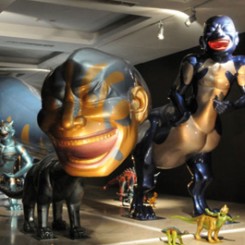Even on the basis of some exclusive if uncertain ‘China’ context, there are better methods that could be employed. Zhang Dali “Second History” 2010 almost avoids artifice altogether, leaving the absence of people and obsessive remodelling of detail to speak for itself. The project involved a five year effort of canvassing China’s archives in search of different versions of historical photographs to compare them against those the artist found in magazines such as People’s Pictorial. Thus the newsprint version of “Mao and Stalin,” 2009, evidences simple cropping and editing of people and the newsprint’s own loss of ‘image quality’. “February 19th, 1953 Chairman Mao on a Navy Warship,” 2005 is presented as a documentary display including a stamp of ‘authenticity’ and evidencing of absurd aesthetic value judgments; for instance, one young sailor receives cosmetic dentistry. Interestingly, the originals are always smaller scaled and black and white, and the finessed images are in colour, albeit somewhat faded, thus emphasising their artificial, ‘produced’ quality. In “The First Sports Meeting of the National Army, 1952,” 2009, no sport is to be seen. Instead two black ellipses (umbrellas) are removed to make way for the Communist Party emblem. How mundane these images are, how banal the editing: that is what is most disturbing. Conversely, Yue Minjun continues to rely on his Cheshire grin, even when you can’t see it.
The second exception to Yue’s cavalcade of oil self-portraits is sculpture, which, like the dinosaurs, has provided respite from painting. These succeed as commentary, as puzzle, as critique in ways that the “Landscapes With No One” series could only hope for; indeed, it is difficult to understand how the same artist could have produced both series of works. One can only speculate that the wrench of reinventing himself from the “laughing artist” has been painful. In “Archaeological Discovery in A.D.3009” (2009), five bronze smiling Yue-figures stand on a low wooden platform, a clearing of two-meter high wooden poles with old-fashioned lamps scattered above (145 x 100 x 75 cm). One eats, one reads, one points and laughs. Surrounding this are three bronze tent-like structures, absent of people but not their remnants, such as a doll and cooking utensils. It presents itself as a museum display or a parody of such. The perverse irony – that in the year 3009, bronze Yue Minjun sculptures aping a primitive civilization will be all that remains of our contemporary civilization for archaeologists to interpret – is delicious but also redundant. For these are not fake cultural artefacts but fake Yue Minjun artefacts in search of conceptualist meaning. The figures could almost be prisoners trapped in Yue’s imagination, wherein the smile that was a strategy through repetition has become unintentionally bathetic. In this there are the fragile seeds of an alternative practice, one where Yue becomes his own principal critic.
The Spirit Scenes from Time Past. Yue Minjun Solo Exhibition of Paintings Series “Landscapes with No One” at Shanghai Gallery of Art, Shanghai, April 19-May 23, 2010
Acknowledgments to Associate Professor Dr Rex Butler, University of Queensland, Australia and his book An Uncertain Smile, Artspace Visual Arts Centre, Woolloomooloo, 1996.
Robert Musil, The Man Without Qualities, trans. Sophie Wilkins and Burton Pike, 1995, Alfred A. Knopf: London, p.325 (Der Mann ohne Eigenschaften, Neu-Edition, ed. Prof. Adolf Frisé, 1978, Rowohlt Berlag GmbH: Reinbeck bet Hamburg).
Note: Parts of this essay appeared in April 2008 on mooreandmooreart.co.uk under the title of “Yue Minjun’s Smile.”
